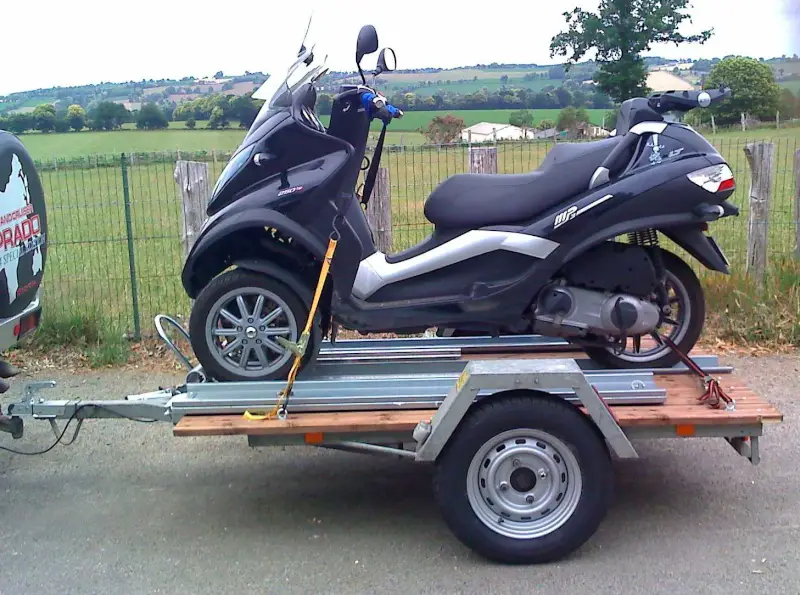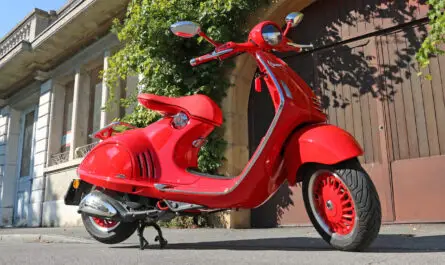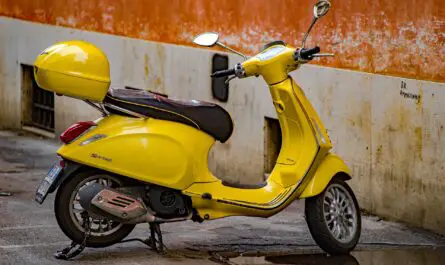To transport a scooter safely, it is important to attach it correctly. To keep your scooter in place during the trip, there are 3 main steps you need to follow:
- Setting up the scooter
- Front wheel fixing
- The rear tire wrap
In this article, we are going to explain in detail how can you attach your scooter to a trailer?
Setting up the scooter
Step 1: Attach a wheel chock to the rear of the trailer bed.
A wheel chock is a slot for the front tire. It keeps the tire straight while transporting the scooter.
- Start by attaching a chock to the bed of your trailer or truck.
- Position it at the back of the bed and center it.
- Then bolt it on. Wheel chocks are available at auto stores or online.
Some trailers already have holes for accessories like wheel chocks. Look for the pre-drilled holes for the bolts. You can also install a wheel chock temporarily if you don't want to worry about fixing screws and bolts. Position it in the same way, then secure it with ratchet straps. The strap tension will hold the cleat in place.
Products you will need:
Step 2: Load the scooter into the trailer using a ramp:
- Use a specialized scooter ramp that can support the weight of your scooter.
- Secure the ramp to the trailer bed. Then gently roll the scooter into the truck bed.
- Do not let go of it at any time, as it could tip over and cause damage to your scooter.
This operation is much easier with two people, one standing on each side. Some utility trailers have built-in ramps, or are low enough that you don't need a ramp. Do not use wood planks for this job. They may not support the weight of the scooter. If you are loading the scooter into a van, remove the tailgate if you can. They sometimes cannot support the weight of a scooter and could break.
Products you will need:
Step 3: Place the front wheel in the wheel chock:
Roll the scooter to the back of the trailer and put the front wheel in the chock. On most chocks, the mechanism engages when the front wheel fully enters it. When you hear this click, the scooter is in the correct position.
Do not lower the kickstand. You can take it out temporarily while you are gathering your gear, but lift it up before you attach the scooter.
Front wheel fixing
Step 4: Hold the scooter upright
If you are working with another person, this task is much easier. Have him hold the scooter upright, without leaning to one side. The easiest way is for the other person to sit on the scooter as if they are driving it and plant both feet.
If you don't have a partner to work with, you can still secure the scooter. Use the kickstand while you are putting everything in place, but raise it up before securing the scooter.
Step 5: Attach one end of the strap to the side of the trailer, in line with the front tire
- Use standard tie-down straps found at a hardware store.
- Drive forward until you are level with the front tire. It doesn't matter which side you start with.
- Then attach the end of a strap to the body of the trailer.
- Pull on it to make sure the knot is secure.
Some trailers and trucks have designated tie-down points. Look for hooks or loops indicating a tie-down point. If your trailer does not have one, attach the strap to a side bar on the trailer. Do not use regular rope for this job. The rope will not work with a ratchet, and you will not be able to tighten it enough.
Products you will need:
Step 6: Thread a strap around one of the front suspension tubes
- Start with the hanger tube on the same side where you attached the strap.
- Loop around the tube, over the rubber parts of the shock absorber. Some scooters have a cross member designed for knotting.
- Check if your scooter is equipped with this attachment. Do not wrap the straps around the shock absorbers, the rubber parts of the suspension.
Step 7: Attach the other end of the strap to a ratchet strap and tighten it
- Tie a rope with a ratchet strap attached to the trailer in front of the front tire.
- Thread the first strap through the ratchet strap, then rotate the ratchet crank to tighten the strap.
- Stop when the strap is tight.
- If you have a partner, have them sit on the scooter so they don't pull the strap on one side.
Products you will need:
Step 8: Repeat the process on the opposite side of the front wheel
Once one of the sides is secured, level the scooter with another strap. Repeat for the other side of the front wheel. Tie the strap on one side, loop around the hanger tube, then tighten it with a ratchet strap. Equal force will keep the scooter upright.
Try rocking the scooter back and forth to make sure the straps are evenly taut. Once the front wheel is attached, your partner can stop holding or sitting on the scooter.
Products you will need:
Ratchet strap to tighten your scooter
Wrap the rear tire
Step 9: Attach a strap parallel to the rear tire
When the front tire is finished, switch to the rear tire. Line up the strap with the rear tire on each side and attach it to the trailer at that location.
If the trailer is equipped with hooks or other tie-downs, secure the strap at this point.
Step 10: Roll up the strap and tie it off
- Pull the strap towards the tire and pass it through the buckle.
- Wind the tire one full turn, then pull the strap to the other side of the trailer.
- Make sure you only wrap the strap around the tire, not around the spokes.
- Then attach the ratchet strap to the opposite side of the trailer.
- Then pass the strap through the ratchet. Turn the crank to tighten the strap, and continue until it is taut.
Step 11: Tie the free ends of the strap so they don't wiggle
The straps that wiggle can damage your car and scooter if you are driving at high speed. Finish the job by securing all the ends. You can either tie them to the trailer or wrap them around the taut part of the strap and tie a knot.
Watch the straps as you drive. Take a look in your rearview mirror to see if any of them have come off, and stop to reattach it if it has.
Learn more about your scooters:
Here is an article that serves as a guide and helps you choose your scooter better before purchasing. For this, we give you the details on the characteristics and the different types of scooter.




